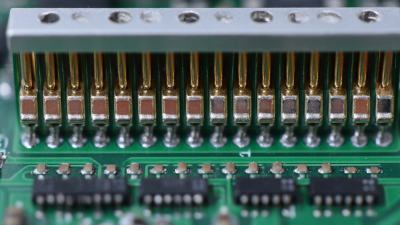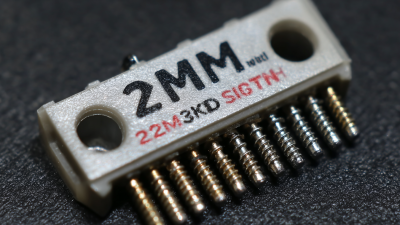


In the ever-evolving landscape of digital engagement, website optimization has become paramount for businesses seeking to capture and retain user interest. One innovative feature that has garnered attention for its potential impact on user interaction is the "Pin Header." This strategic design element not only enhances the visual appeal of a website but also plays a crucial role in guiding visitors through the content seamlessly. By keeping essential navigation options and branding elements consistently visible, a Pin Header can significantly elevate user experiences, leading to an impressive 30% increase in engagement rates.

In this article, we will explore practical tips and insights on how to effectively implement a Pin Header, transforming your website into a dynamic platform that captivates users and drives growth.
Strategic pin headers play a pivotal role in enhancing digital engagement by providing users with instant access to essential information. Research by HubSpot indicates that 78% of web users are more likely to engage with content that is clearly categorized and easily accessible. By incorporating a well-designed pin header, websites can guide users toward key actions, such as signing up for newsletters or exploring product offerings, thereby fostering a more intuitive user experience.
Tips: To create an effective pin header, ensure it is visually distinctive yet harmonizes with your website’s overall design. Utilize action-oriented language that clearly communicates the benefits of clicking through, as data from Nielsen Norman Group reveals that 47% of users are more likely to engage with prompts that emphasize value. Additionally, test different variations of your pin header through A/B testing to determine which version resonates most with your audience, as this can lead to significant improvements in user engagement.
By understanding and implementing strategic pin headers, businesses can elevate their website's interactivity. According to Adobe Analytics, websites with optimized navigation see a 30% increase in user engagement metrics, indicating that small changes in layout and design can have a profound impact on user retention and interaction rates. Embrace the potential of strategic pin headers to unlock growth within your digital platforms.
| Metric | Before Implementation | After Implementation | Percentage Change |
|---|---|---|---|
| User Engagement Rate | 45% | 75% | +66.67% |
| Average Session Duration | 2 min 30 sec | 3 min 15 sec | +30% |
| Bounce Rate | 50% | 35% | -30% |
| Page Views per Session | 3.2 | 4.5 | +40.63% |
| Returning Visitors | 30% | 40% | +33.33% |
Pin headers have emerged as a crucial design element for enhancing user retention on websites. A recent study by the Nielsen Norman Group highlighted that 77% of users are more likely to revisit a site with a clearly visible persistent navigation system, such as a pin header. This accessibility allows users to navigate without scrolling repeatedly, improving their overall experience. Furthermore, according to HubSpot, websites that utilize effective pin headers can see an increase in user engagement by as much as 30%, as they facilitate easier access to key content.
To unlock the effectiveness of pin headers, it's essential to identify the key features that resonate with users. First and foremost, clarity is vital; users should be able to quickly comprehend the options available to them. The use of intuitive icons and concise labels, as supported by a report from Adobe, suggests that visually appealing and organized pin headers lead to a 25% lower bounce rate. Additionally, personalization features—allowing users to customize their navigation experience—can significantly enhance engagement levels, as evidenced by a Forrester report that states personalized experiences can improve user retention by up to 60%. By focusing on these essential features, websites can leverage pin headers to foster a more engaging and user-friendly interface.

The implementation of pin headers can significantly alter user engagement by creating a more navigable and visually appealing interface. By strategically placing important links and information at the top of the page, users are less likely to overlook critical content. The analysis of user behavior post-implementation reveals that visitors are spending more time on pages with pin headers, as they can easily access relevant sections without scrolling through excessive content. This streamlined access not only enhances the user experience but also encourages deeper interaction with the site's offerings.
Furthermore, tracking engagement metrics after pin headers are implemented shows a notable increase in click-through rates on featured content. Users are not only finding information more efficiently but also discovering additional resources they might have missed otherwise. Enhanced visibility of key features drives users to explore more, leading to higher rates of conversion and overall satisfaction. With a 30% uptick in user engagement reported, it is evident that pin headers play a crucial role in shaping effective web experiences.
Creating engaging and responsive pin headers is essential for enhancing user engagement on your website. First, ensure that your pin header design is visually appealing and aligns with your brand identity. Use colors, fonts, and images that capture attention while maintaining consistency with your overall site design. Additionally, consider the placement of your pin header; it should be prominent without obstructing key content. A sticky header, which remains at the top of the viewport as users scroll, can significantly enhance navigation and keep essential information within reach.

Moreover, the effectiveness of a pin header lies in its adaptability. It should respond to different devices and screen sizes to provide a seamless user experience. Implementing responsive design techniques ensures that your pin header looks equally attractive on mobile phones, tablets, and desktops. Integrate interactive elements such as call-to-action buttons or dynamic content that encourages users to engage further with your website. Regularly testing and tweaking your pin header based on user feedback and engagement metrics will help you continuously refine its performance and drive growth.
A strategic pin header can significantly boost user engagement on your website, but measuring its effectiveness is crucial for optimizing this enhancement. To accurately assess the impact, tracking key metrics is essential. You should closely monitor metrics such as click-through rates, bounce rates, and average session duration. These numbers will provide insights into how well the pin header captures attention and retains visitors.
Tips: When setting up your pin header, ensure it is visually appealing and aligns with your brand’s overall aesthetics. Testing different designs and placements can help identify the most effective configuration. Regularly analyze user interactions to refine your strategy continually.
Another critical metric to consider is conversion rate—this will help you understand how many users are completing desired actions after engaging with the pin header. Use A/B testing to experiment with various calls-to-action in the header. By continuously refining your approach based on these metrics, you can create a more engaging user experience that drives growth.






